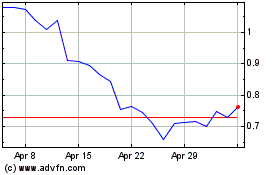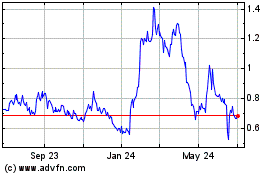Vaxart Announces Last Subject Dosed in Phase 1 Trial of Its Norovirus Vaccine Candidate in Lactating Mothers
December 21 2023 - 8:00AM

Vaxart, Inc. (Nasdaq: VXRT) today announced that it has completed
enrollment and dosing in the Phase 1 clinical trial evaluating
Vaxart’s oral pill bivalent norovirus vaccine candidate focused on
lactating mothers.
“This is an important step forward as we drive
toward a vaccine candidate that may make it possible for mothers to
protect their children against this highly contagious – and
potentially lethal -- virus. We look forward to announcing topline
data from this study by the end of 2024,” said Dr. James F.
Cummings, Vaxart’s Chief Medical Officer. “We are very proud of our
clinical team for completing enrollment of this trial within our
planned timeline.”
There is no approved vaccine against norovirus,
which sickens approximately 21 million people in the United States
each year, and 15% of children under age 5 contract norovirus
annually. Approximately 3 million sets of parents are forced by
this virus to miss work -- approximately 2.2 days on average -- to
care for their children. The annual disease burden from norovirus
is $10.6 billion in the U.S. alone.
Globally, norovirus has become the leading cause
of pediatric gastroenteritis in health care settings in countries
that have adopted a rotavirus vaccine program.1 Pediatric deaths in
the United States due to norovirus are rare, but they are much more
common in the developing world.
About the VXA-NVV-108 Clinical
Trial
The Phase 1, multicenter, randomized,
double-blind, placebo-controlled single dose, dose-ranging study is
designed to evaluate the safety, tolerability, and immunogenicity
of orally administered bivalent GI.1/GII.4 norovirus vaccine in
healthy lactating females of at least 18 years of age. The study
enrolled 76 subjects at five sites in South Africa. Subjects are
randomized into high- or low-dose vaccine (N=30 for each arm) or
placebo (N=16). The primary endpoints are:
- Frequency, duration and severity of solicited symptoms of
reactogenicity (local and systemic) for one week following study
drug dose;
- Frequency, duration and severity of unsolicited
treatment-emergent adverse events (TEAEs), serious AEs (SAEs),
adverse events of special interest (AESIs) and new onset of chronic
illness (NOCIs) through the active period (four weeks post
dose);
- Serum VP1-specific (GI.1 and GII.4) IgA on Day 1 (baseline),
Day 8 and Day 29 (four weeks post last dose);
- Breastmilk VP1-specific (GI.1 and GII.4) IgA on Day 1
(baseline), Day 8 and Day 29 (four weeks post last dose).
Further information, including information about
study funding, can be found in the Company’s press release of
December 1, 2022, as well as the Company’s latest quarterly
filing.
1 Shah and Hall, Infect Dis Clin North Am. 2018
Mar; 32(1): 103-118.
About Vaxart Vaxart is a
clinical-stage biotechnology company developing a range of oral
recombinant vaccines based on its proprietary delivery platform.
Vaxart vaccines are designed to be administered using pills that
can be stored and shipped without refrigeration and eliminate the
risk of needle-stick injury. Vaxart believes that its proprietary
pill vaccine delivery platform is suitable to deliver recombinant
vaccines, positioning the company to develop oral versions of
currently marketed vaccines and to design recombinant vaccines for
new indications. Vaxart’s development programs currently include
pill vaccines designed to protect against norovirus, coronavirus,
seasonal influenza, and respiratory syncytial virus (RSV), as well
as a therapeutic vaccine for human papillomavirus (HPV), Vaxart’s
first immune-oncology indication. Vaxart has filed broad domestic
and international patent applications covering its proprietary
technology and creations for oral vaccination using adenovirus and
TLR3 agonists.
Note Regarding Forward-Looking
Statements This press release contains forward-looking
statements that involve substantial risks and uncertainties. All
statements, other than statements of historical facts, included in
this press release regarding Vaxart's strategy, prospects, plans
and objectives, results from preclinical and clinical trials and
the timing of such results, commercialization agreements and
licenses, and beliefs and expectations of management are
forward-looking statements. These forward-looking statements may be
accompanied by such words as "should," "believe," "could,"
"potential," "will," "expected," “anticipate,” "plan," and other
words and terms of similar meaning. Examples of such statements
include, but are not limited to, statements relating to Vaxart's
ability to develop and commercialize its product candidates,
including its vaccine booster products; Vaxart's expectations
regarding clinical results and trial data, and the timing of
receiving and reporting such clinical results and trial data; and
Vaxart's expectations with respect to the effectiveness of its
product candidates. Vaxart may not actually achieve the plans,
carry out the intentions, or meet the expectations or projections
disclosed in the forward-looking statements, and you should not
place undue reliance on these forward-looking statements. Actual
results or events could differ materially from the plans,
intentions, expectations, and projections disclosed in the
forward-looking statements. Various important factors could cause
actual results or events to differ materially from the
forward-looking statements that Vaxart makes, including
uncertainties inherent in research and development, including the
ability to meet anticipated clinical endpoints, commencement,
and/or completion dates for clinical trials, regulatory submission
dates, regulatory approval dates, and/or launch dates, as well as
the possibility of unfavorable new clinical data and further
analyses of existing clinical data; the risk that clinical trial
data are subject to differing interpretations and assessments by
regulatory authorities; whether regulatory authorities will be
satisfied with the design of and results from the clinical studies;
decisions by regulatory authorities impacting labeling,
manufacturing processes, and safety that could affect the
availability or commercial potential of any product candidate,
including the possibility that Vaxart's product candidates may not
be approved by the FDA or non-U.S. regulatory authorities; that,
even if approved by the FDA or non-U.S. regulatory authorities,
Vaxart's product candidates may not achieve broad market
acceptance; that a Vaxart collaborator may not attain development
and commercial milestones; that Vaxart or its partners may
experience manufacturing issues and delays due to events within, or
outside of, Vaxart's or its partners' control; difficulties in
production, particularly in scaling up initial production,
including difficulties with production costs and yields, quality
control, including stability of the product candidate and quality
assurance testing, shortages of qualified personnel or key raw
materials, and compliance with strictly enforced federal, state,
and foreign regulations; that Vaxart may not be able to obtain,
maintain, and enforce necessary patent and other intellectual
property protection; that Vaxart's capital resources may be
inadequate; Vaxart's ability to resolve pending legal matters;
Vaxart's ability to obtain sufficient capital to fund its
operations on terms acceptable to Vaxart, if at all; the impact of
government healthcare proposals and policies; competitive factors;
and other risks described in the "Risk Factors" sections of
Vaxart's Quarterly and Annual Reports filed with the SEC. Vaxart
does not assume any obligation to update any forward-looking
statements, except as required by law.
Contacts
Vaxart Media
Relations: Mark Herr Vaxart,
Inc. mherr@vaxart.com(203)
517-8957
Investor Relations: Andrew BlazierFINN
PartnersIR@vaxart.com(646) 871-8486
Vaxart (NASDAQ:VXRT)
Historical Stock Chart
From Mar 2024 to Apr 2024

Vaxart (NASDAQ:VXRT)
Historical Stock Chart
From Apr 2023 to Apr 2024
